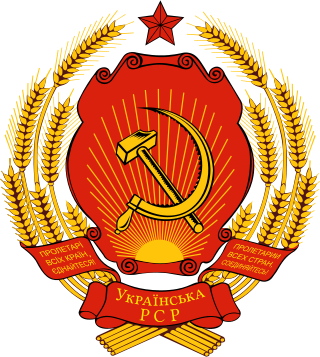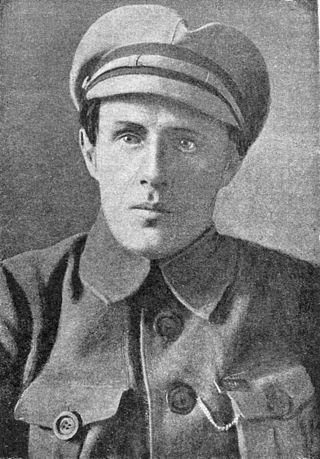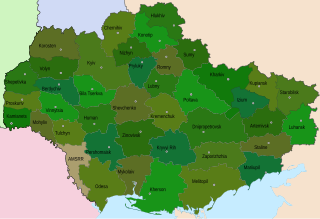
The Communist Party of Ukraine was the founding and ruling political party of the Ukrainian SSR operated as a republican branch of the Communist Party of the Soviet Union (CPSU).
Ukrainian Socialist-Revolutionary Party was a political party in Ukraine and the Russian Republic founded in April 1917, based on separate groups and circles of SRs that existed on the territory of Ukraine since 1905. The left faction of the party dissolved it in 1918 forming a new party, while the Ukrainian Socialist-Revolutionary Party was recreated in January 1919 by its moderate faction members.

Volhynia Governorate, also known as Volyn Governorate, was an administrative-territorial unit (guberniya) of the Southwestern Krai of the Russian Empire. It consisted of an area of 71,736 square kilometres (27,697 sq mi) and a population of 2,989,482 inhabitants. The governorate bordered Grodno and Minsk Governorates to the north, Kiev Governorate to the east, Podolia Governorate to the south, Lublin and Siedlce Governorates, and after 1912, Kholm Governorate and Austria to the west. Its capital was in Novograd-Volynsky until 1804, and then Zhitomir. It corresponded to most of modern-day Volyn, Rivne and Zhytomyr Oblasts of Ukraine and some parts of Brest and Gomel Regions of Belarus.

Kiev Governorate was an administrative-territorial unit (guberniya) of the Russian Empire from 1796 to 1919 and the Ukrainian Soviet Socialist Republic from 1919 to 1925. It included the territory of the right-bank Ukraine and was formed after a division of the Kiev Viceroyalty into Kiev and Little Russia Governorates in 1796. Its capital was in Kiev. By the early 20th century, it consisted of 12 uyezds, 12 cities, 111 miasteczkos and 7344 other settlements. After the October Revolution, it became part of the administrative division of the Ukrainian SSR. In 1923 it was divided into several okrugs and on 6 June 1925 it was abolished by the Soviet administrative reforms.

The Kiev Bolshevik Uprising was a military struggle for power in Kiev after the fall of the Russian Provisional Government in the October Revolution. It ended in victory for the Kievan Committee of the Bolshevik Party and the Central Rada.

Andrei Vasilyevich Ivanov was a Soviet activist and politician.

All-Ukrainian Central Executive Committee was a representative body of the All-Ukrainian Congress of Soviets. It was the supreme legislative, administrative, executive controlling state power of Soviet Ukraine between the sessions of the Congress of Soviets that acted between 1917 until 1938. In the very beginning this institution was established as the Central Executive Committee of Soviet of Ukraine at the First All-Ukrainian Congress of Soviets in Kharkiv on December 24–25, 1917. At the same congress was elected the People's Secretariat of Ukraine.

During its existence from 1919 to 1991, the Ukrainian Soviet Socialist Republic consisted of many administrative divisions. Itself part of the highly centralized Soviet Union, sub-national divisions in the Ukrainian SSR were subordinate to higher executive authorities and derived their power from them. Throughout the Ukrainian SSR's history, other national subdivisions were established in the republic, including guberniyas and okrugs, before finally being reorganized into their present structure as oblasts. At the time of the Ukrainian SSR's independence from the Soviet Union, the country was composed of 25 oblasts (provinces) and two cities with special status, Kiev, the capital, and Sevastopol, respectively.

An okruha is a historical administrative division of the Ukrainian Soviet Socialist Republic that existed between 1923 and 1930. The system was intended as a transitional system between the Russian Imperial division of governorates and the modern equivalent of oblasts.

The All-Ukrainian Congress of Soviets was the supreme governing body of the Ukrainian Soviet Socialist Republic from 1917–38. From 1922 to 1938 the Constitution of the Ukrainian SSR, modeled on the 1918 Russian Constitution, mandated that Congress to be convened at least twice a year. The 1926 Constitution lowered the minimum to once a year.
Isaak Mironovich Kreisberg was Soviet political figure of Ukraine.

The administrative division of Ukraine in 1918 was inherited from the Russian Empire, and based on the largest unit of the gubernia with smaller subdivisions county or district, and rural district.

Tavria Okruha was an administrative subdivision of the Ukrainian State (Ukraine) created in April 1918. The okruha was governed by a starosta from Berdiansk. The territory consisted of the continental part of the earlier Tavria guberniia, without the territory of the Crimean Peninsula.
The Provisional Workers-Peasants Government of Ukraine was a provisional Soviet government created on November 28, 1918, in Kursk on decision of the Communist Party of Ukraine and help of the Russian Workers-Peasants Red Army (RKKA), with its place of location was assigned the city of Sudzha. On the same day the government released its manifest. This Soviet government was created in the very same way as the Provisional Workers' and Peasants' Government of Belorussia which on 1 January 1919 also issued its manifest in Minsk. The Provisional Workers-Peasants Government of Ukraine became the highest legislative, executive and administrative body of Soviet power in Ukraine as the Soviet Russia resumed hostilities against Ukraine.

The Ukrainian People's Republic (UPR) was a short-lived state in Eastern Europe. Prior to its proclamation, the Central Council of Ukraine was elected in March 1917 as a result of the February Revolution, and in June, it declared Ukrainian autonomy within Russia. Its autonomy was later recognized by the Russian Provisional Government. Following the October Revolution, the Central Council of Ukraine denounced the Bolshevik seizure of power and proclaimed the Ukrainian People's Republic with a territory including the area of approximately eight Russian imperial governorates. It formally declared its independence from Russia on 22 January 1918.

Yuri Petrovich Gaven, born Jānis Daumanis, was a Latvian revolutionary and Soviet politician and Chekist. He was a key figure in the defeat of the Crimean People's Republic and the establishment of the short-lived Taurida Soviet Socialist Republic and an active participant in the Red Terror in Crimea. Executed during the Stalinist purges in 1936, he was rehabilitated in 1958.
Semyon Izrailevich Zapadny was a Chekist, state security commissar of 3rd degree, member of the NKVD special troikas, a chief of the Kiev Okruha GPU (KGB) in 1925-1928 and Khabarovsk Oblast in 1934–37.

Alexander Yakovlevich Shumsky or Oleksandr Yakovych Shumskyi was a Ukrainian communist and activist. He was one of the leaders of the national communism movement in Ukraine and actively supported Ukrainization. He was one of the victims of the Stalinist regime, being arrested and killed by the NKVD in 1946. He was rehabilitated in 1958, during the period of De-Stalinization.
The Donetsk Gubernatorial Committee of the Communist Party of Ukraine, commonly referred to as the Donetsk CPU gubkom, was a regional branch of the Communist Party of (Bolsheviks) Ukraine in Donetsk Governorate.
The Establishment of Soviet power in Russia was the process of establishing Soviet power throughout the territory of the former Russian Empire, with the exception of areas occupied by the troops of the Central Powers, following the seizure of power in Petrograd on October 25, 1917, and in mostly completed by the beginning of the German offensive along the entire front on February 18, 1918.













